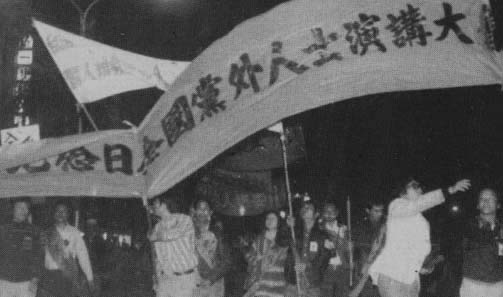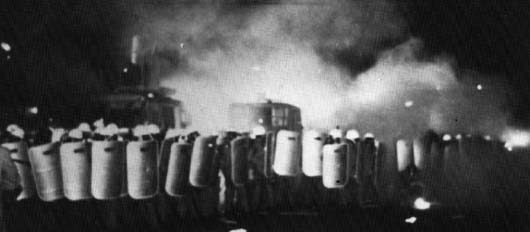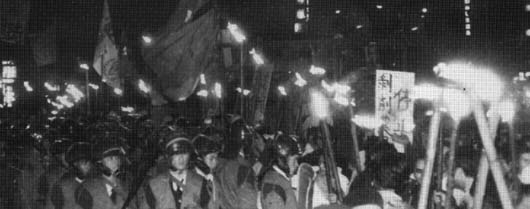
December 10th, 1979 was a major moment in Taiwan's history. When it took place, it was hardly noticed internationally, but since then it has been recognized as an important turning point in the island's recent transition to democracy. It galvanized both the Taiwanese people in Taiwan as well as the overseas Taiwanese community into political action.
The movement subsequently formed the basis for the democratic opposition of the DPP and its overseas support network of Taiwanese organizations in North America and Europe. Virtually all leading members of the present-day democratic opposition had a role in the event, either as defendants or as defense lawyers.
Below, we present a summary of the event and its aftermath, while a full account is given in our publication The Kaohsiung Tapes (60 pages, 1300 Kbytes, Acrobat PDF-file), which carries a translation of sound tapes made during the evening of 10 December 1979. Extensive present-day coverage of the commemorations of the Kaohsiung Incident in Taiwan can be found in the Taipei Times.

The now well-known event of the evening of 10 December 1979 started out as the first major human rights day celebration on the island. Until that time the authorities had never allowed any public expression of discontent, but in the summer of 1979 a slight thaw had set in, during which two opposition magazines were established: Formosa Magazine, headed by veteran opposition Legislative Yuan-member Huang Hsin-chieh, and The Eighties, headed by up and coming opposition leader K'ang Ning-hsiang.
Formosa Magazine quickly became the rallying point for the budding democratic movement. During the fall of 1979, it became increasingly vocal, and it was only natural that it would use 10 December as an opportunity to express its views on the lack of democracy and human rights on the island. When the day arrived, the atmosphere had become tense because of increasingly violent attacks by right-wing extremists on offices of the magazine and homes of leading staff members.
What happened on that fateful evening is history: the human rights day celebration ended in chaos after police encircled the peaceful crowd and started using teargas, and pro-government instigators incited violence.

Newspaper reports right after the event reported that in the ensuing confrontations, more than 90 civilians and 40 policemen were injured. However, in an amazing display of magic, the authorities managed to end up with 182 policemen and 1 (!!!) civilian injured. Although most injuries were relatively minor, the authorities quickly played up the injuries on the police side, sending high officials and TV- and film-actresses to the hospitals to comfort the injured policemen.
More seriously, three days later, the KMT authorities used the incident as an excuse to arrest virtually all well-known opposition leaders. They were held incommunicado for some two months, during which reports of severe ill-treatment filtered out of the prisons.
The arrested persons were subsequently tried in three separate groups: in March/April 1980, the eight most prominent leaders (the "Kaohsiung Eight") were tried in military court and were sentenced to terms ranging from 12 years to life imprisonment.
In April/May 1980, a second group of 33 persons, the "Kaohsiung 33", who had taken part in the Human Rights Day gathering were tried in civil court and sentenced to terms ranging from 2 to 6 years.
A third group of 10 persons associated with the Presbyterian Church were accused of helping the main organizer of the demonstration, Mr. Shih Ming-teh, when he was in hiding, because he feared torture and immediate execution. Most prominent among this group was Dr. Kao Chun-ming, the general-secretary of the Presbyterian Church. Dr. Kao was sentenced to seven years imprisonment. The others received lesser sentences.
The importance of the incident is in the fact that it galvanized both the Taiwanese people in Taiwan as well as the overseas Taiwanese community into political action. The movement which grew out of the incident subsequently formed the basis for the present-day democratic opposition of the DPP and its overseas support network of Taiwanese organizations in North America and Europe.
In the following, we wish to focus on two aspects:
"In 1981, I graduated from college. Before we entered the military service, a few of my friends got together to celebrate. During dinner, my friends brought up the subject of Kaohsiung Incident. They were regular readers of "tangwai" magazines and were criticizing the KMT authorities handling of the incident. As I was not familiar with the tangwai magazines, I initially did not quite believe what my friends told me.
Then one of them told us a shocking story: He said that at the time of the Kaohsiung Incident, his cousin, who was serving in the military police, was member of a unit which was ordered to dress up like civilians and to beat up the uniformed military police in order to aggravate the conflict between the oppositionists and the military police. He said that afterwards his cousin felt deeply depressed and regretted the fact that he had played a role as instigator at the Kaohsiung Incident.
After I entered the military service, I was assigned to the military police myself. In 1983 in a celebration for the Chinese New Year, the battalion commander and the political commissar of my unit, after a couple of drinks, were bragging about the heroic acts of the military police. They said that since the death of Chiang Kai-shek, the military police has been sidelined. But since the Kaohsiung Incident, the authorities had regained their confidence in the military police.
I then pressed them for an explanation. They told me the story of their joint experience: In 1979, the battalion commander was stationed in Tainan, and the political commissar was stationed in Chia-yi. More than a month before the Kaohsiung Incident, the different military police units in southern Taiwan were moved around. The unit in Yun-lin was moved to Chia-yi, and the unit in Chia-yi was moved to Kaohsiung. They said the authorities planned the Kaohsiung Incident.
The strategy was to surround the oppositionists with three layers. The first layer was the military police, the second layer was the army and the third layer was the police. They received order from their superiors that they should not fight back if they were beaten. Between 2:00 and 3:00 p.m. in the afternoon of December 10, 1979 (four hours before the demonstration commemorating Human Rights Day started, and before any irregularities had taken place -- Ed.), the military police, the army and the police had already taken up positions.

When the event took place during the evening of December 10th, the military police marched forward and closed in on the demonstrators, then they retreated again to their original position. This was repeated two or more times. The battalion commander explained that the purpose of this exercise was to cause panic and fear in the crowd and also to provoke anger and confusion.
The political commissar also said that the number of injured military police were exaggerated. Even those who suffered only minor scratches were hospitalized. Many of the low ranking soldiers were thrilled to see high officials come to the hospital to pay them visits and to offer them money. They were excited by the visits of film actresses, who came to give them flowers and kisses."
Some of the former Kaohsiung prisoners discussed their treatment in prison for the first time ten years after the Kaohsiung Incident in interviews with The Journalist and Freedom Era.
Mr. Huang Hsin-chieh. After his release in May 1987, Mr. Huang returned to political life in Taiwan again: in October 1988 he was elected chairman of the DPP-party, and at the end of October 1989, he was re-elected to a second term. Mr. Huang passed away in November 1999.
"I was taken to the basement of An Kang Detention Center of the Investigation Bureau of the Ministry of Justice. The interrogation continued non-stop for seven or eight days. They wanted me to confess to things that I completely had no knowledge of. When I refused to cooperate, they pounded the table and shouted at me. They used intimidation and coercion. They threatened to give me harsh treatment, if I did not cooperate. They told me that if I cooperated with them, they would let me go home to spend the Lunar New Year with my family. The "confession" was prepared by them. They asked me to copy it but I refused to put my signature on it. Then they threatened to arrest my brother and my daughter. I finally gave in."
Mr. Chang Chün-hung. Mr. Chang was also released in May 1987. He has served as Secretary-General of the DPP-party. His wife was elected to the Legislative Yuan in 1980, and was re-elected twice since then.
"I was imprisoned in the basement of An Kang Detention Center of the Investigation Bureau. My interrogators had three shifts. Every shift varied from two to three people. The interrogation continued non-stop for seven days. They screamed at me and poured cold water on me, when I about to close my eyes and fall asleep. They also slapped my face. The basement was extremely quiet. The quietness frightened me.
When the interrogators came marching with heavy steps, it was frightening to hear the noise of their boots and their shouting of passwords. I did not know whether they were coming to get me out to go through another round of non-stop interrogation, to confess to things that I did not know about. The interrogation centered on the "five-member committee" and "the short and long term plan to seize power." In fact, there was no such plan, it was a complete fabrication by the Investigation Bureau. The "confession" was also fabricated by them. At first, I refused to put my signature on it. Then they threatened to arrest my wife and my sister. I did not want my family to suffer, so I signed the "confession."
Ms. Chen Chü. Ms. Chen was released in February 1986. She has since been very active in Taiwan's human rights movement, and served as executive director of the Taiwan Association for Human Rights (TAHR), Taiwan's most prominent and active human rights organization. From 1995 through 1998 she served as Director for Social Services in Taipei City. In May 2000, she was appointed Minister for Labor Affairs in the new DPP government.
"I was taken to the An Kang Detention Center of the Investigation Bureau. The interrogation continued non-stop for at least three days. On the fourth day, they let me go back to my cell at midnight. But early in the morning at 5 AM, they took me back for further interrogation. There were four shifts of interrogation. Every shift had four people. The Investigation Bureau now denied that physical violence was used. They did slap me in the face and often treated me with verbal abuse.
What frightened me the most was not knowing when the interrogators would appear again in front of the door to drag me out for another round of questioning to confess to things that I had no knowledge of. All the interrogators refused to tell their names. It was not until after the Jung-hsing scandal (a bribery scandal involving members of the Taipei City Council -- Ed.) broke out that I found out from a television news report that one of my interrogators was Wong Tsu-ch'o, the son of the former chief of the Investigation Bureau. We were watched 24 hours. There was a spot light, a one-way mirror in my cell. Even when I went to the toilet and took a bath, someone was with me all the time."
Ms. Lü Hsiu-lien. Ms. Lü -- a prominent women's rights leader even before the Kaohsiung Incident -- was released on medical bail in March 1985. Since then she spent some time at Harvard University, continuing her studies. She returned to Taiwan in 1992 and ran successfully for a seat in the Legislative Yuan. In 1997 she was elected to the position of County Magistrate for Taoyuan County. In March 2000, she was elected Vice-President of Taiwan.
"I was detained at the Ching Mei Detention Center. Although they did not beat me up physically, they used different methods of intimidation and threats, which were even more frightening: once, they showed me the picture of the bullet-ridden body of Wu Tai-an after he was executed. They said to me: "Open your eyes. Look at this bloody mess. You will be the second Wu Tai-an. This is how you will end up." They also wanted me to read the notice, which was sent to the wife of Wu Tai-an notifying her to come and pick up her husband's remains.
They said to me : "Read this notice, read it loud. Do you hear me ? Soon your family will receive the same notice." They also told me: "Wu Tai-an died with bare chest. That wouldn't be appropriate for a girl." Besides this type of intimidation, they also mistreated me in other ways, such as refusing to give me food, ordering me to stand facing the wall for several hours on end. Sometimes they ordered me to eat a big meal, which was meant for two people. Even the "confession" had to be tailored to their needs. If they didn't like it, they tore it up and ordered me to write it over again."
Mr. Lin Yi-hsiung. Mr. Lin, a former Provincial Assembly-member, was treated most harshly during his interrogation. On 28 February 1980, his mother and two of his daughters were murdered in one of the most gruesome -- and still unsolved -- political murders in Taiwan. Mr. Lin was released in August 1984. Since then he has devoted himself to study and research. In mid-1998, he was elected as Chairman of the Democratic Progressive Party (DPP), in which position he served until July 2000.
The following is an excerpt from a statement Mr. Lin Yi-hsiung wrote on 25 February 1980, three days before the murders took place.
"If the investigators were not satisfied with an answer, they would keep hitting me until I couldn't bear it any longer. I shall never forget the verbal intimidation, and what some of the investigators said to me: "If you don't talk and give us the evidence, we will beat you. If you get beaten to death, we will just say that you committed suicide out of fear or guilt. If you don't talk we will knock all your teeth out."
The nameless man who beat me was fierce and evil. One look at him and I would shiver. His modus operandi was punches and kicks. To scare and intimidate me, he often threatened to have me dragged down to the basement. For about ten days, he punched my chest, back, and abdomen. He kicked me in the shins and in the stomach. Sometimes he held a lit cigarette against my face. "
Back to: Taiwan's 400 years of history
Last modified 26 May 2001